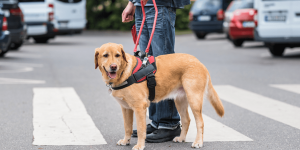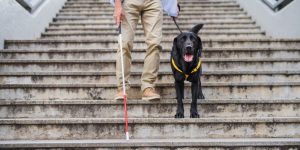5 Myths About Guide Dogs.
Guide dogs worldwide are specially trained to provide crucial assistance to people who have lost their sight. The first four guide dogs in Britain were trained in 1931. Three years later, the Guide Dogs for the Blind Association was born.
The jobs these dogs perform are so important in helping blind people to maintain independence – they are trained to carry out many tasks that would be much more difficult for blind people without the assistance of a ‘seeing eye’ dog.
However, there are quite a few misconceptions about guide dogs, so Holidays4Dogs looks at 5 lesser known facts about these clever canines.
Guide dogs…
…Are always working.
Assistance dogs always get time off. When they are not ‘working’ they get the chance to do all the things a normal pet dog would do.
They have very happy lives, living in family homes, with plenty of exercise, stimulation, socialisation and lots of down time. Some would say, far better lives than some pet dogs.
However, when you see an assistance dog in harness with his, or her owner, you should refrain from distracting, or petting the dog, unless you have asked the owner if this is OK. Certainly, never interact with a dog helping his owner to negotiate crossing the road, for example.
…Know when to cross a road.
It is true that guide dogs are trained not to walk into on-coming traffic. However, they are unable to make the decision on when to cross.
However, they are unable to make the decision on when to cross.
This is largely down to the owner who will use a crossing facility and/or listen in order to decide when it is safe to cross.
Guide dogs in Britain are not taught to use pelican crossings as standard, (by pressing buttons with their paws). However, there have been reports of assistance dogs who are capable of doing this.
Ultimately, guide dogs do not make decisions on when it is safe to cross the road; only the handler can do this.
…Know exactly where to go.
Dogs that guide their owners, can become familiar with routes their owner takes frequently. However, they are trained generally to move from kerb to kerb. An assistance dog will guide their owner centrally along the pavement, avoiding obstacles.
They still need guidance and instruction on which way to go and which way to turn. People with support dogs still sometimes need to rely on asking other people for directions.
…Are not friendly.
When you see a support dog working he will be focusing intently on the task at hand, but this doesn’t mean to say he isn’t sociable, or friendly. Indeed, an assistance dog couldn’t do his job if he wasn’t sociable and friendly.
However, it is still important for people not interact with a dog while he is in the process of guiding his owner (see point above). Likewise, consider the owner; even if he is in a café with his dog sleeping at his feet, the person in question may rather enjoy his, or her, coffee in peace in the same way anyone might.
…Can not judge height and width.
Indeed, they can. Specialist training allows guide dogs to judge height and width, so their owners don’t bang their heads, or crash into narrow spaces.
…Conclusion.
Guide dogs are not quite clever enough to read signs, or make important safety decisions. However, the assistance they provide to blind, or partially sighted people, is invaluable.
If you would like to know more about how you can support guide dog training, follow the link here.




